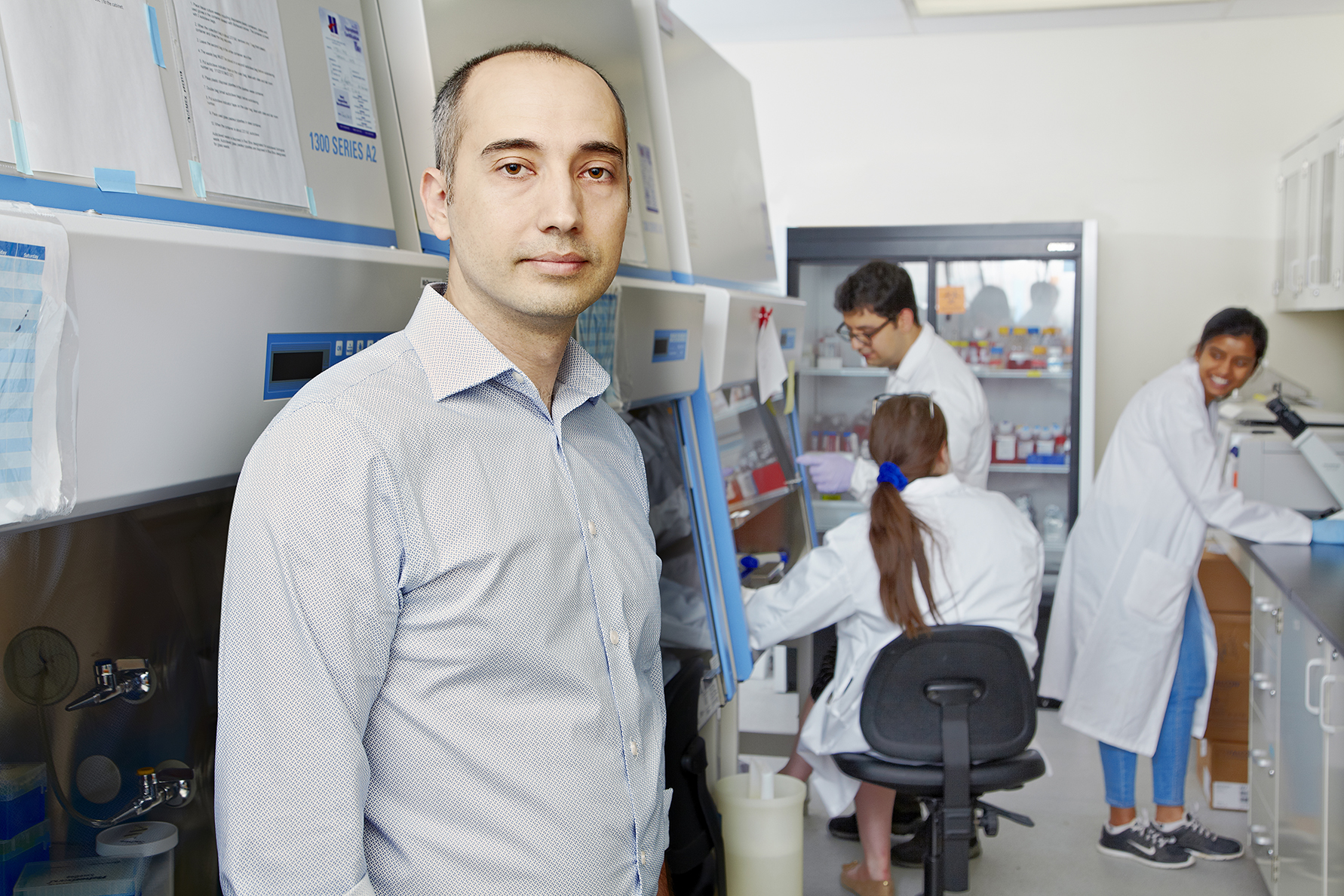Regenerate
by Dan Falk
photography by sofie Kirk
Leukemia, multiple sclerosis, Parkinson’s disease, spinal cord injuries – these are very different ailments with one thing in common: all can potentially be treated with therapies rooted in stem cells. Known since the 1960s, when they were discovered by Canadian researchers Ernest McCulloch and James Till, stem cells have incredible potential value for regenerative medicine.
Research such as that being carried out at the Stem Cell Engineering Lab at York University finds that stem cells can develop into many different types of cells within the body, with a multitude of possible functions. No other cell in the human body is so malleable. But a major obstacle is that stem cells, once removed from a donor’s body, typically only stay alive for a couple of days.
“If we try to keep them alive in a dish, they die,” explains Eleftherios (Terry) Sachlos, York’s Stem Cell Engineering Lab director and principal investigator. With a PhD in tissue engineering and 3D printing from the University of Oxford, Sachlos continued his work with stem cells during his postdoctoral research at Harvard, MIT and McMaster. He joined York in 2014.
One of his main goals in this capacity is to figure out what conditions are needed to make stem cells survive for longer periods. Demand for stem cells always outstrips supply, so being able to grow them in the lab could have tremendous payoff. “We’re asking,” Sachlos says, “how can we keep these blood stem cells alive in a dish, so that we can grow more of them?”

For Sachlos, a cell’s environment is the key: conditions in a plastic dish are nothing like those within the human body, so the first step is to be able to move beyond the petri dish to a more realistic environment. Ideally, that environment would closely resemble and mimic that of real bone marrow.
“By engineering the bone marrow, we’re creating a ‘house’ for these stem cells. We’re creating these micro-environments, so that when the cells get removed from the body, it’s not too much of a shock for them.”
The challenge of keeping stem cells alive combines basic biology with techniques drawn from engineering – which makes it perfectly suited to Sachlos’s combination of talents. “We’re using engineering principles to try to control and manipulate the cells,” he says. That includes building a 3D matrix, a sponge-like structure in which cells can live and thrive as they would in human bone marrow.
The move to a 3D environment is crucial, says Farrah Sawh, a graduate student working in York’s Stem Cell Engineering Lab. “Traditionally, cell cultures have been created in a flat, 2D plastic dish,” she says. “But we’re not 2D organisms; we’re 3D.”
The next step is to duplicate the body’s building materials – calcium, collagen, elastin and the various proteins that hold it all together. In the lab located in York’s Life Sciences Building, Sawh tries out different combinations of those key ingredients, honing in on those that produce the best results.
“If you get even half of the cells still living after five days,” she says, “then you’re doing something right.”
It’s clear that there’s a growing demand for stem cells across North America. According to a recent report, the stem cell market is increasing by some 9.5 per cent annually. “Stem cells have the potential to transform the treatment of several chronic and incurable diseases,” says Sandra Donaldson, vice-president of the Ontario Institute for Regenerative Medicine.
We’re mindful that the work that we’re doing is applied research. We want to see the benefits trickle down to patients.…
“Innovative stem cell therapies have the potential to improve the quality of life of affected patients and families,” and can also generate considerable economic benefits as the technologies become commercialized, she says. At the Stem Cell Engineering Lab, which opened last year, research is front and centre – but with an eye on commercialization. Sachlos has been working with several industry partners and has been involved with the Bergeron Entrepreneurs in Science & Technology program at York, which supports tech-based start-ups.
“We’re mindful that the work that we’re doing is applied research,” says Sachlos. “We want to see the benefits trickle down to patients, and the best way you can do that is through a commercialization route.”
Bone marrow transplants have been used to treat leukemia since the late 1950s; so far, more than one million transplants have been carried out, with some 50,000 people receiving a bone marrow graft every year worldwide.
But bone marrow transplants also offer hope for the treatment of autoimmune diseases such as multiple sclerosis (MS), Sachlos says.
Unfortunately, bone marrow transplants remain dangerous; the mortality rate is about 10 per cent. In the case of leukemia, because the disease is so deadly, patients often decide to have the transplant despite the risks.
Because MS is less deadly, patients sometimes choose to forgo the transplant and live with the disease and its consequences. But if those transplants could be made safer, it would be a big step forward, Sachlos says, and having more stem cells available could do just that.
“What if we could get that 10 per cent down to 0.1 per cent? What if we could make it safer?” That can potentially be achieved just by having more stem cells available. “The more stem cells you inject, the safer it becomes.” ■